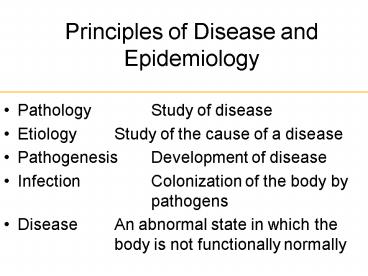Principles of Disease and Epidemiology - PowerPoint PPT Presentation
1 / 18
Title:
Principles of Disease and Epidemiology
Description:
Animal Rabies, Lyme disease. Some zoonoses may be transmitted to humans ... Lyme disease. Public Health failure. Diphtheria; Ebola virus. Emerging Infectious ... – PowerPoint PPT presentation
Number of Views:574
Avg rating:3.0/5.0
Title: Principles of Disease and Epidemiology
1
Principles of Disease and Epidemiology
- Pathology Study of disease
- Etiology Study of the cause of a disease
- Pathogenesis Development of disease
- Infection Colonization of the body by
pathogens - Disease An abnormal state in which the body
is not functionally normally
2
The Microbial World
- Microbes or microorganisms are too small to be
seen (as individuals) with unaided eye - Includes bacteria and archaea, fungi, protozoa,
and microscopic algae - Most are free-living and not harmful
- Most important role is cycling of chemical
elements
3
Normal Microbiota and the Host
- Microbiota are microorganisms that colonize the
body - Transient microbiota may be present for days,
weeks, or months - Normal microbiota permanently colonize the host
- Symbiosis is the relationship between normal
microbiota and the host
4
Relationships
- In commensalism, one organism is benefited and
the other is unaffected. - In mutualism, both organisms benefit.
- In parasitism, one organism is benefited at the
expense of the other. - Some normal microbiota are opportunistic
pathogens. - Normally commensal, occasionally parasitic
5
Normal Microbiota and the Host
- Locations of normal microbiota on and in the
human body
Figure 14.2
6
Kochs Postulates
- Koch's Postulates are used to prove the cause of
an infectious disease.
Figure 14.3.1
7
Kochs Postulates
- Koch's Postulates are used to prove the cause of
an infectious disease.
Figure 14.3.2
8
Classifying Infectious Diseases
- Symptom A change in body function that is
felt by a patient as a result of disease - Sign A change in a body that can be measured
or observed as a result of disease. - Syndrome A specific group of signs and
symptoms that accompany a disease.
9
Classifying Infectious Diseases
- Communicable disease A disease that is spread
from one host to another. - Contagious disease A disease that is easily
spread from one host to another. - Noncommunicable disease A disease that is
not transmitted from one host to
another.
10
Severity or Duration of a Disease
- Acute disease Symptoms develop rapidly
- Chronic disease Disease develops slowly
- Subacute disease Symptoms between acute and
chronic - Latent disease Disease with a period of no
symptoms
11
Extent of Host Involvement
- Local infection Pathogens limited to a small
area of the body - Systemic infection An infection throughout the
body - Focal infection Systemic infection that
began as a local infection - Bacteremia Bacteria present in the blood
- Septicemia Growth of bacteria in the blood
12
Extent of Host Involvement
- Toxemia Toxins in the blood
- Viremia Viruses in the blood
- Primary infection Acute infection that causes
the initial illness - Secondary infection Opportunistic infection after
a primary (predisposing) infection - Subclinical disease No noticeable signs or
symptoms (inapparent infection)
13
The Stages of a Disease
Figure 14.5
14
Reservoirs of Infection
- Reservoirs of infection are continual sources of
infection. - Human AIDS, gonorrhea
- Carriers may have inapparent infections or latent
diseases - Animal Rabies, Lyme disease
- Some zoonoses may be transmitted to humans
- Nonliving Botulism, tetanus
- Soil, water
15
Nosocomial (Hospital-Acquired) Infections
- Are acquired as a result of a hospital stay
- 5-15 of all hospital patients acquire nosocomial
infections
Figure 14.7, 9
16
Emerging Infectious Diseases
- Diseases that are new, increasing in incidence,
or showing a potential to increase in the near
future. - Contributing factors
- Evolution of new strains
- V. cholerae O139 HIV
- Inappropriate use of antibiotics and pesticides
- Antibiotic resistant strains
- Changes in weather patterns
- Hantavirus
17
Emerging Infectious Diseases
- Contributing factors
- Modern transportation
- West Nile virus
- Ecological disaster, war, expanding human
settlement - Coccidioidomycosis
- Animal control measures
- Lyme disease
- Public Health failure
- Diphtheria Ebola virus
18
Epidemiology































